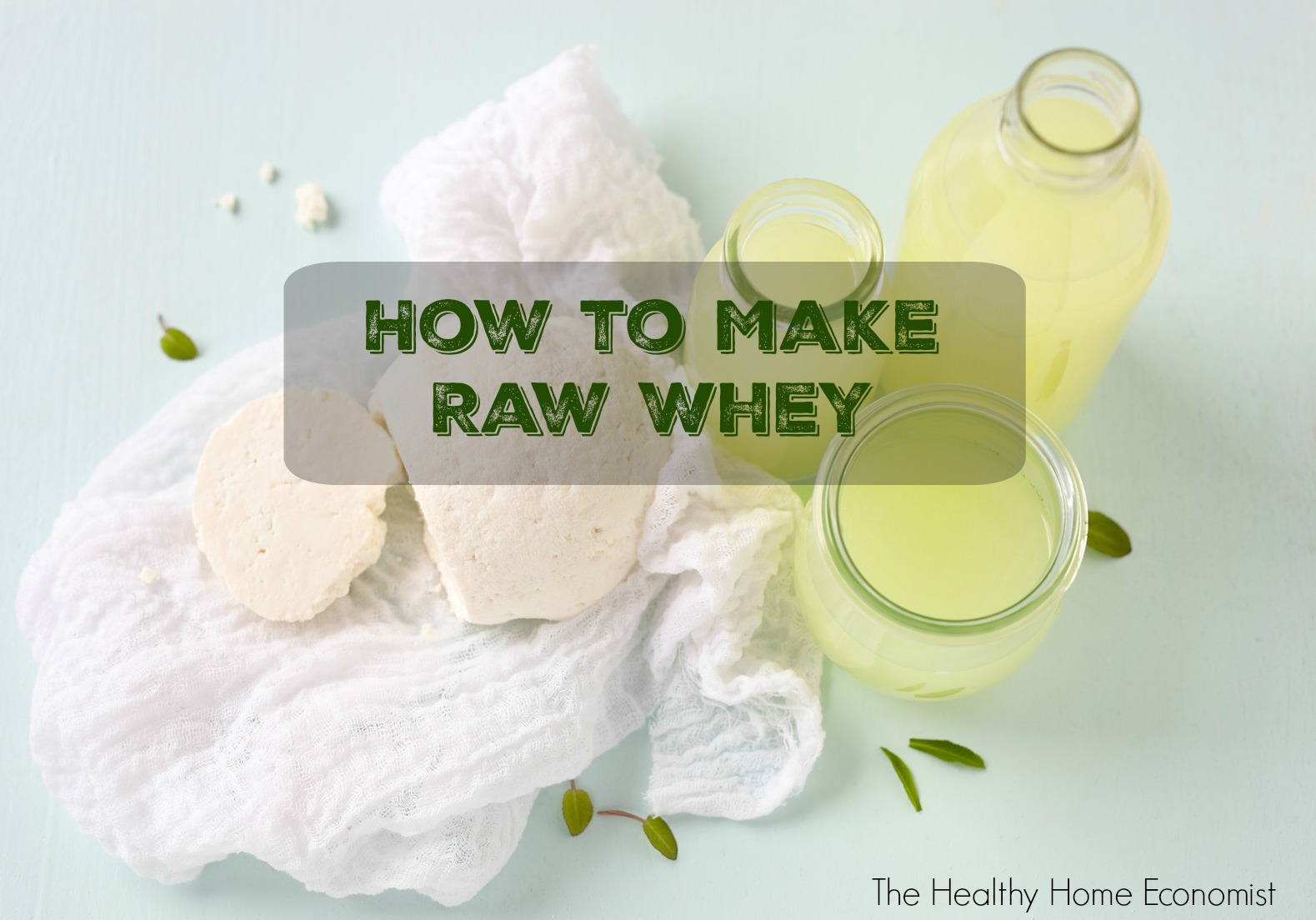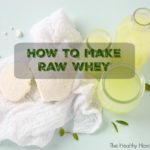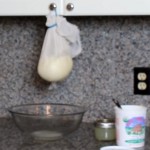How to make raw, enzyme and probiotic-rich liquid whey to use as a starter culture for all your home fermentation needs.

Do you know how to make whey from yogurt, kefir or raw milk?
A by-product of this simple technique is healthy homemade cream cheese that is loaded with enzymes and probiotics.
The recipe below describes how with visual instructions via video demonstration!
Making homemade baby formula? I recommend using this “quick whey” no straining method as the fastest and easiest approach.
How to Make Whey the REAL Way
Making real, liquid, nutrient rich, unadulterated whey in your own kitchen is a MUST step for any traditional cook to learn.
Without whey in its whole, liquid form, many other traditional recipes cannot even be attempted. You cannot buy whey from the store except in a denatured, unhealthy, powdered whey form. It is worth your time to learn what I show you in the video below.
Other video lessons on this blog show you how to use this whole food form of whey to make many delicious, healthful recipes for your family. Whey as made in the video demo below will keep up to 6 months in the refrigerator in a sealed mason jar.
If you absolutely have no access to farm fresh milk to make whole, unadulterated, enzyme rich whey, then you can use plain, organic yogurt brand from the store instead. Here are tips on how to spot the best yogurt brands.
The process is basically exactly the same thing as shown in the video.
You won’t get nearly as much whey using yogurt as clabbered, farm fresh milk, but at least you can get enough to get you started.
Wonderful Whey and REAL Cream Cheese
The raw, enzyme-rich cream cheese I make in the recipe video below is fantastic on a sprouted or sourdough bagel for breakfast. Don’t buy the Ezekiel sprouted muffins as they contain soy. This low-carb bagel recipe is another great one to try.
If you prefer to buy, these sourdough bagels are available for shipping freshly made to your door.
To make, just take your cream cheese left over from making liquid whey and add a few strawberries and a dash of dark maple syrup to taste. Mix together by pulsing a few times in your food processor. This wonderful, fresh, REAL strawberry cream cheese will last one to two weeks in the refrigerator. Another wonderful use for this healthy raw cheese is to make an easy no bake cheesecake.
No access to raw milk where you live? No problem. Check out this recipe plus video on how to separate whey from yogurt purchased from the store.
Cloudy Whey vs Clear Whey
No matter whether your whey turns out cloudy or clear, it is safe and fine to use in all your favorite recipes. This article explains why sometimes whey is cloudy compared to its usual golden color.

Raw Whey Recipe
How to separate raw, liquid whey from clabbered milk. The process also creates probiotic rich cream cheese.
Ingredients
- 1 quart raw milk preferably grassfed
- 1 large glass bowl
- 1 large rubber band
- 1 white dishtowel
Instructions
-
Allow the raw milk to sit on the counter for 1-3 days at room temperature.
-
When the milk separates into curds and whey (transforms into clabbered milk) you are ready to proceed. Note that the fresher the raw milk and the colder the temperature of your house, the longer it will take the raw milk to clabber.
-
Line a clean, large glass bowl with a clean, white dishtowel that isn’t too thick. Cheesecloth will also work, but the holes in the mesh must be very small, else the milk curds will pass through.
-
Gently pour the clabbered milk into the middle of the dish towel. Gather up the ends and fasten with a rubber band. Attach to a knob on an upper cabinet in your kitchen as shown in the picture.

-
Let the raw whey drip into the bowl underneath. This process will continue for an hour or two.
-
After the dripping stops, gently take down the hanging bag and place it into a clean bowl. Scrape out the raw cream cheese that is inside the bag, put in a container with a lid and refrigerate.
-
Pour the liquid whey from the dripping bowl into a glass mason jar, afix the lid and refrigerate.
-
Refrigerated, raw cream cheese will be good to eat for about a week. Raw whey will last several months refrigerated.
Recipe Video
How to Use Whey in Recipes
How to Make Ricotta Three Ways (plus Video How-to)
Perfect Probiotic Cottage Cheese
Cheese Making: Common Problems and Solutions








Hi Sarah firstly I just want to say that your blog has changed my life. I haven’t been able to have dairy for years now without rushing to the loo but since I stumbled across your blog and the wonders of raw milk and a traditional diet I can enjoy whole fat dairy again.
I was talking to an ex dairy farmer the other day and was telling her about cream cheese made from clabbered raw milk and she thought it was a bit disgusting. She said I was just eating rotten milk (although I’ve done it a few times and had no problems). She said the milk is cooled to 4oC (I’m from Australia, don’t know what that is in F). Anyway she said doing this kills off nearly all the bacteria. That doesn’t make sense to me but was wondering what you thought?
I read all the comments thinking that I might find the answer to my question. It’s similar to Laura’s last question: How sour should the milk be? My actual question is: how long does it take for milk to sour in the refrigerator? The people who sold me the milk said milk is good for about 7 days. How many days after 7 days before it sours? What is the LONGEST time we can leave the milk (in an effort for it to sour) in the refrigerator before we should just toss it?
I’ve had raw milk in the ‘fridge that was over 3 weeks old and still tasted just fine.
Hi Sarah!
I tried this method a few weeks ago, and had trouble at the clabbering stage. I left the raw milk on the counter as you did for a bit over 24 hrs, and there was still just mostly liquid…nothing left in my towel. I assume my milk wasnt “sour enough”
How sour should the milk be?
Any thoughts? Cannot wait to get this right, and start some lemonade 🙂
I am having the same issue.
I need some help. I just went to use some whey that I had in the fridge and it was moldy. It has happened once before after 5 months or so. This time it was after 6 weeks. I have read it should last quite awhile.
The whey was made the same way I have always done. I make homemade yogurt from raw milk, strain it through a flour sack towel or coffee filter and put in a mason jar in my fridge.
Any advice would be appreciated.
Laura
Is this video still available? It’s not loading for me for some reason. I can see all the text from the post just now the video… Anyone else having issues?
nevermind, I restarted my computer and it worked! Thanks!
Can you use butter muslin instead of a tea towel to drain the cream cheese? I am swimming in soured raw milk and am looking for creative way to use it.
Hi Sarah,
Thank you for this tutorial! My milk was on the counter for 36 or so hours and clabbered, I went ahead with the separation step and the “whey” is not as light in color as yours in the video. I am making this whey to primarily use it as an ingredient in the raw baby formula. Is my whey safe to use? Again, it’s not light in color, it still looks “milky”. Thanks!
Hello Sarah, It’s Maria from JAX 🙂 My grass-fed organic, soy-free raw milk in the 1/2 gal soured after 7 days of vacation in the fridge. With about 1/3 of the half gallon left I put it on it’s side on the counter after 24 hrs it has not clabbered? Am I doing something wrong?
Thanks
I see that you recommend not using powdered whey because it is typically denatured and processed. However, the only powdered whey I consume is non-denatured. Well Wisdom uses milk from organic Wisconsin cows and contains the “full range of all the fragile immune-modulating and regenerative components naturally present in fresh raw milk.”
Do you think this (unflavored, of course) would be acceptable?
please can you address the question many people have asked about thesourcow y taste of the cream cheese thanks
Raw cream cheese does have a slight sour taste but isn’t overwhelmingly so.